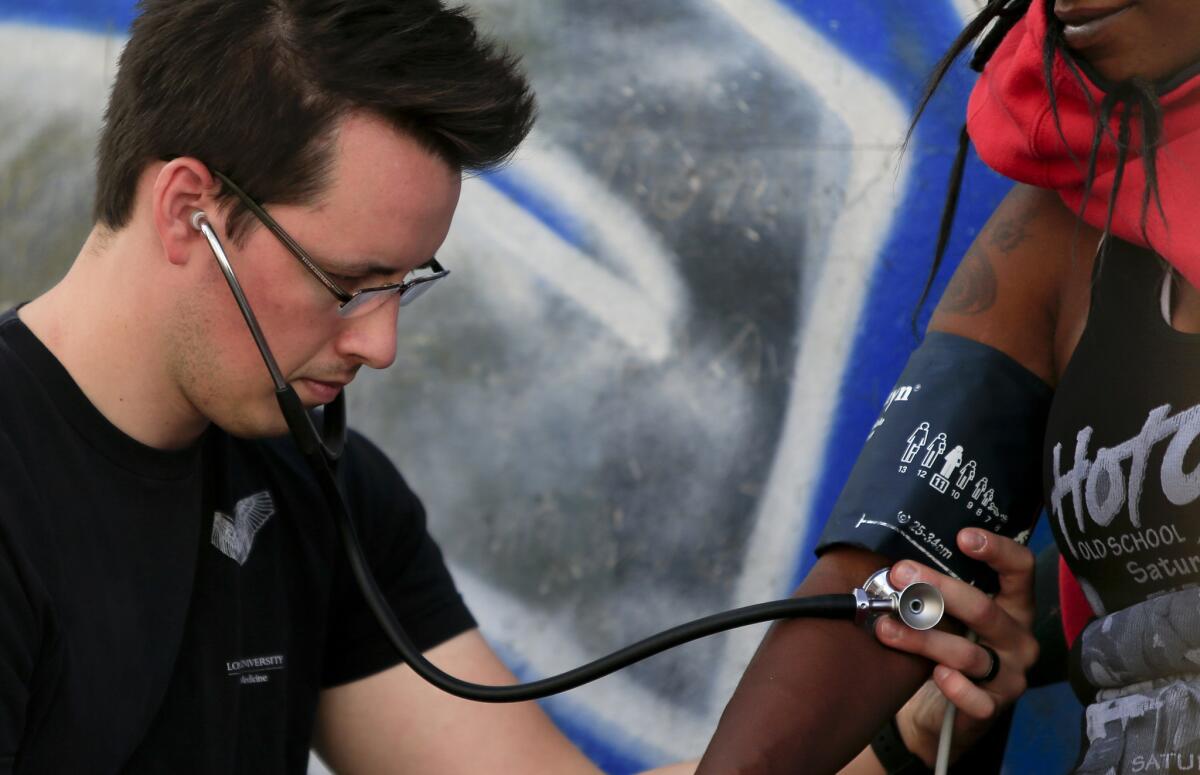How often do you go to the doctor? It depends on where you live, study says

Dr. James Cunningham checks the blood pressure of a woman in downtown Los Angeles. A new study finds that the chances that an adult has seen a doctor in the last year vary greatly by state, from a low of 51.9% in Montana to a high of 84.1% in Vermont.
The odds that you’ve seen a doctor in the last year vary quite a bit depending on where you live — but so far, the way your state has implemented the Affordable Care Act doesn’t seem to have much to do with it, government data show.
A new report from the Centers for Disease Control and Prevention finds that 17.3% of American adults did not have a home base for their medical care in 2014, and 34% had not seen or talked to a doctor in the last year.
But those figures ranged considerably from state to state.
Residents of Vermont had the best access to medical care: 84.1% of them had visited or been in touch with a doctor in the past year, and 97.2% said they had a place to go if they needed medical attention.
In four other states — Delaware, Massachusetts, Wisconsin and Hawaii — at least 90% of residents had a medical home, and in two other states — Delaware and Virginia — at least 75% of residents had seen or talked with a doctor in the past year.
At the other end of the spectrum, in three states — Nevada, Idaho and Texas — more than 25% of residents didn’t have a regular place to receive medical care. In three other states — Montana, South Dakota and Alaska — more than 45% of people had gone more than a year without seeing or talking to a doctor.
California was close the national average on both scores. In the Golden State, 36.7% of adults hadn’t seen or talked with a doctor in the past year, and 18.9% lacked a usual place to seek care.
Although access to medical care varied greatly by state, the researchers found little difference when they grouped states according to their response to the ACA (also known as Obamacare).
Among the 25 states (plus the District of Columbia) that expanded their Medicaid programs in the wake of the federal law, 66.7% of residents had seen or spoken with a doctor in the last year, on average. In the other 25 states that did not expand Medicare, the figure was 65.2% — a difference too small to be considered statistically significant.
The researchers did find a slight but real difference in residents’ likelihood of having a usual place of care: 83.4% had a medical home in states that expanded Medicare, on average, compared with 81.8% in states that didn’t.
“Many factors likely influence rates of healthcare utilization, and rates may change as the length of time since ACA implementation increases,” the report authors concluded.
The findings are based on adults ages 18 to 64 who participated in the CDC’s National Health Interview Survey. The report was produced by the agency’s National Center for Health Statistics.
Follow me on Twitter @LATkarenkaplan and “like” Los Angeles Times Science & Health on Facebook.
ALSO
Tesla Motors posts a bigger loss, and two key executives plan to leave
LAPD hacked into iPhone of slain wife of ‘Shield’ actor, documents show
San Andreas fault ‘locked, loaded and ready to roll’ with big quake, expert says




